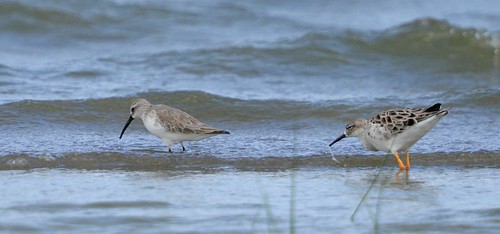tags: Curlew Sandpiper, Calidris ferruginea, Ruff, Calidris pugnax, birds, mystery bird, bird ID quiz
[Mystery birds] Curlew Sandpiper, Calidris ferruginea, and Ruff, Calidris pugnax, photographed in the Nyumba ya Mungu reservoir, Tanzania, Africa. [I will identify this bird for you in 48 hours]
Image: Dan Logen, February 2010 [larger view].
Nikon D300, 600 mm lens x 1.4. ISO 320, 1/800 sec, f/6.3.
Please name at least one field mark that supports your identification.


With its orange legs and scaled pattern, the Ruff (Philomachus pugnax) seems the more straight forward of the two. Its more drab mate might be a Curlew Sandpiper (Calidris ferruginea) an ID supported by the longish decurved bill, longish primary extension and scapulars showing white edges, (creating a scaly appearance) and a dark mid-line.
The long decurved bill removes the other possibility of Dunlin.
Also there appears to be some reddish feathers appearing on the breast, summer plumage developing?
Adrian,
Have you considered the slightly larger (and therefore very similar in length to the Ruff) and similarly winter-plumaged Curlew Sandpiper, Calidris ferruginea?
I must have missed something. I thought that Adrian was referring to Michael's id of the bird on the left as a Curlew Sandpiper.
Although I wouldn't say that the long, decurved bill rules out Dunlin -- they actually have long, decurved bills. The bill on a Dunlin typically appears to be straighter near the base, with a curve developing farther out, in contrast to the curve present throughout on a Curlew Sandpiper. The longer body, with longer wings and tail, and the paler breast also help rule out Dunlin.
And I always find it interesting to see how geography influences our viewpoints. Curlew Sandpiper came to me right away -- the Ruff took a little while. I see yellow legs on a big sandpiper, and I think Yellowlegs, which would be pretty remarkable, I think, in Kenya.
Hello David, I think there is some size illusion happening here. Male Ruff should be 26-30cms, Curlew Sandpiper 18 -19cms, Dunlin 16-20cms.
Paul, the longer billed Dunlin ssp "alpina" has an average bill length of 31.1mm (27-35)and Curlew Sandpiper 36.2mm (33-39) so ther is some overlap, but also the cleaner supercilium indicates "ferruginea" as well.
So yes David, I was referring to Curlew Sandpiper and a male Ruff (the white feathering around the bill indicates this) as well picked out by Michael.
Adrian,
I recognise the foreshortening issue and assumed the Curlew Sandpiper to be a couple of feet behind the Ruff- my sizing assumed the Ruff to be 25cm and certainly the largest of the three species in question, with the Culew Sandpiper and Dunlins approximately at about 18cm with many authors saying that the Dunlin usually comes in smaller than the CS... (sizing as recorded by the Patuxent Wildlife Research Center)
for some weird reason, the comments above my first were all mixed up and both your and Michael's descriptions seem to have changed order and composition since then... or is Paul right, I have cabin-fever (too many warblers)?
Hey Paul, we're in Tanzania (although I think the reservoir is something like 25 miles from the border)!
Anyway, my thoughts were that the Dunlin didn't get as far as where this photo was taken, recorded in northern Kenya as a vagrant but not in Tanzania?
Hello David, You may be right, I can't find any Dunlin records for Tanzania and only four for Kenya. Curlew Sandpiper is said to be "abundant in coastal areas and more local inland, between August to early May" so this is more than likely for the identification.
Hey Adrian,
This is a distribution map of the Curlew Sandpiper in Tanzania as of June 2008- if you follow the northern border from the coast, that first juke right-and-left is approximately where the Nyumba ya Mungu Reservoir is located and as you can see, there are multiple records for that location.
Ooops....
I don't know why, but my reading comprehension just seems to vanish when I look at locations.
I guess yellowlegs would be pretty remarkable for Tanzania as well as Kenya, though.
Although Paul, the other two of that closely-allied Tringa trio are indeed found in Tanzania and as you can see, both recorded at the Nyumba ya Mungu Reservoir:
distribution map of the Spotted Redshank in Tanzania
distribution map of the Greenshank in Tanzania